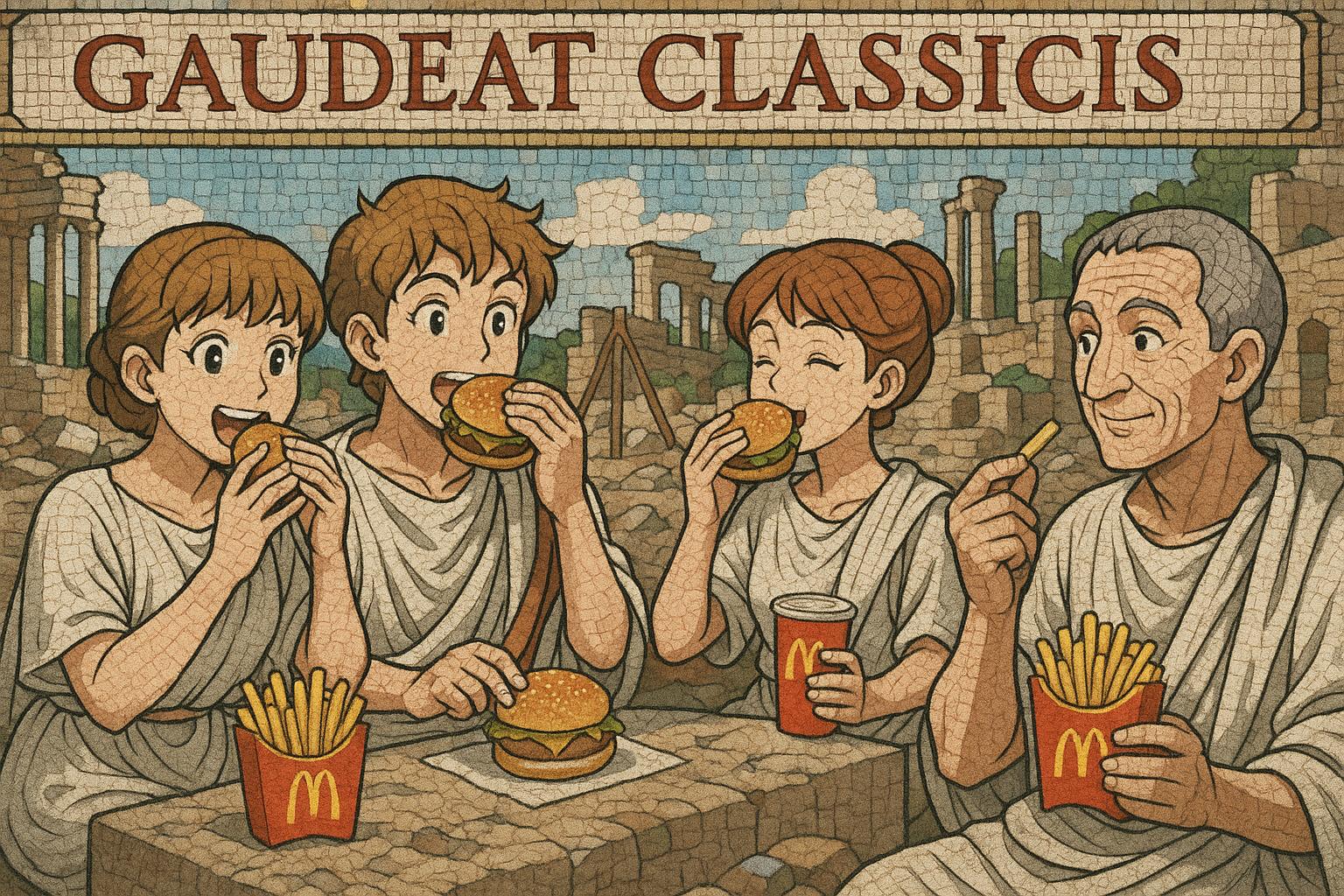McDonald’s Italia has unveiled an 18,000-piece mosaic at Rome’s Galleria Alberto Sordi mall blending its classic menu with Roman archaeological themes. The controversial campaign highlights the brand’s ongoing experiment with cultural integration, sparking mixed reactions over the balance between homage and commercial intrusion.
McDonald’s Italia has taken a striking step into the world of cultural integration with its newly unveiled 18,000-piece mosaic at the Galleria Alberto Sordi mall in Rome. This extraordinary creation features four toga-clad figures delighting in familiar McDonald’s fare, such as burgers and fries, cleverly positioned within an archaeological dig theme. Surrounding these characters is the inscription “GAUDEAT CLASSICIS”, which translates to “Enjoy the classics”. This phrase serves both to celebrate the chain’s iconic menu items and to invoke the grandeur of Rome’s rich historical context.
This mosaic is part of a broader advertising campaign aimed at intertwining McDonald’s classic offerings with the timeless allure of the Roman era, prompting consumers to indulge in both the ancient and the contemporary. Reaction to the advertisement has been mixed among locals; while some appreciate its creative homage to Roman culture, others feel it intrudes upon a revered heritage, comparing it to an unfortunate imposition akin to installing a drive-through at a historical site.
McDonald’s relationship with Italy’s archaeological landscape is not new, with past encounters that showcase the brand’s unique approach to historical preservation. Notably, in 2014, construction workers in Frattocchie, just outside Rome, unearthed a 45-metre stretch of an ancient Roman road embedded with skeletons. Instead of halting construction, McDonald’s opted to invest €300,000 into integrating this archaeological find into the restaurant’s design, creating what has been dubbed the world’s first “restaurant-museum”. This establishment allows diners to view the ancient road through a glass floor, cementing the modern dining experience with historical intrigue.
Mario Federico, managing director of McDonald’s Italia, referred to this innovative approach as a fusion of contemporary fast food and archaeological exploration, highlighting how the past can enrich the present. Since the opening of its first outlet in Rome at the Spanish Steps in 1986, the brand has burgeoned to over 750 locations across Italy, cementing its place within the cultural fabric of the nation.
The mosaic initiative, while unique to McDonald’s, fits into a broader trend where brands leverage historical themes for marketing. This tactic has been seen previously with Coca-Cola’s 2023 ‘Masterpiece’ Campaign, which creatively incorporated renowned artworks to connect with consumers, demonstrating that the line between homage and exploitation can often be delicate.
Moreover, similar strategies have been employed by diverse brands like Maxam Toothpaste, which launched a campaign in China that visually linked dental health to the decay of ancient civilizations, employing striking imagery that provokes thought about both history and personal care.
As McDonald’s continues to navigate this thin line between clever tribute and cultural intrusion, the acceptance of its marketing efforts will largely depend on how well they resonate with the sensibilities of its audience. The delicate balance of innovation in advertising while respecting historical legacy remains a pivotal challenge for brands operating in culturally rich environments like Rome.
 Reference Map:
Reference Map:
- Paragraph 1 – [1], [2]
- Paragraph 2 – [1], [3], [6]
- Paragraph 3 – [4], [5]
- Paragraph 4 – [1], [5]
- Paragraph 5 – [2], [1]
Source: Noah Wire Services
- https://www.afaqs.com/news/brands/mcdonalds-serves-up-history-with-its-new-ancient-mosaic-ad-in-rome-9351445 – Please view link – unable to able to access data
- https://www.afaqs.com/news/brands/mcdonalds-serves-up-history-with-its-new-ancient-mosaic-ad-in-rome-9351445 – McDonald’s Italia has unveiled an 18,000-piece mosaic in Rome’s Galleria Alberto Sordi mall, featuring four toga-clad men enjoying McDonald’s classics like burgers and fries. The Latin inscription ‘GAUDEAT CLASSICIS’ translates to ‘Enjoy the classics’, aligning McDonald’s offerings with Rome’s rich cultural heritage. This campaign has sparked mixed reactions among locals, with some viewing it as a clever tribute and others as an intrusion into cherished legacies. The mosaic is part of a broader brand initiative in Rome that connects McDonald’s classics with the classical period.
- https://www.thelocal.it/20170223/mcdonalds-opens-restaurant-museum-over-ancient-roman-road – In 2017, McDonald’s opened a unique restaurant in Frattocchie, Italy, built atop a 45-metre stretch of ancient Roman road dating back to the 1st-2nd century BC. Discovered during construction in 2014, the road was restored with a €300,000 investment and integrated into the restaurant’s design, allowing visitors to view the archaeological site through a transparent floor. This establishment is considered the world’s first ‘restaurant-museum’, blending modern dining with historical preservation.
- https://www.businessinsider.in/thelife/news/at-this-mcdonaldaposs-in-italy-your-big-mac-comes-with-a-side-of-ancient-ruins/slidelist/114892431.cms – A McDonald’s in Frattocchie, Italy, uniquely incorporates a 150-foot-long stretch of ancient Roman road into its design. Discovered during construction in 2014, the road, built in the 2nd century B.C., was restored with a €300,000 investment and integrated into the restaurant. Visitors can view the ancient road and three skeletons through a glass floor, making it a distinctive dining experience that combines modern fast food with historical exploration.
- https://www.newsweek.com/mcdonalds-2000-year-old-skeletons-italy-1763778 – In Frattocchie, Italy, a McDonald’s restaurant was built over a 45-metre stretch of ancient Roman road discovered during construction in 2014. The road, dating back to the 2nd century B.C., was restored with a €300,000 investment and integrated into the restaurant’s design. Visitors can view the ancient road and three skeletons through a glass floor, offering a unique dining experience that combines modern fast food with historical exploration.
- https://www.telegraph.co.uk/news/2017/02/22/want-ancient-roman-heritage-stretch-roman-road-unveiled-beneath/ – In 2017, McDonald’s opened a restaurant in Frattocchie, Italy, built atop a 150-foot-long stretch of ancient Roman road dating back to the 2nd century B.C. Discovered during construction in 2014, the road was restored with a €300,000 investment and integrated into the restaurant’s design. Visitors can view the archaeological site through a transparent floor, making it the world’s first ‘restaurant-museum’ that combines modern dining with historical preservation.
- https://hyperallergic.com/361416/italian-mcdonalds-serves-up-a-side-of-roman-ruins/ – A McDonald’s in Frattocchie, Italy, uniquely incorporates a 150-foot-long stretch of ancient Roman road into its design. Discovered during construction in 2014, the road, built in the 2nd century B.C., was restored with a €300,000 investment and integrated into the restaurant. Visitors can view the ancient road and three skeletons through a glass floor, making it a distinctive dining experience that combines modern fast food with historical exploration.













